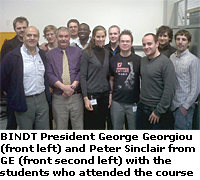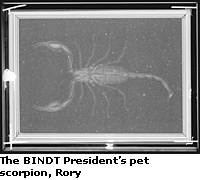Successful postgraduate radiography course at the University of Warwick
19/08/2010
 During the week commencing 22 March 2010, a number of EngD students attended a 3½ day postgraduate Radiography NDT course at the University of Warwick. This was the second time the course has been presented, which focuses more on the theoretical and mathematical aspects of radiography rather than the practical.
During the week commencing 22 March 2010, a number of EngD students attended a 3½ day postgraduate Radiography NDT course at the University of Warwick. This was the second time the course has been presented, which focuses more on the theoretical and mathematical aspects of radiography rather than the practical.The course was organised by Dr Steve Dixon (Chair of the NDT Technical Committee of BINDT) on behalf of the UK’s Research Centre in Non-Destructive Evaluation (RCNDE). It was developed by Dr George A Georgiou (President, BINDT) in association with Dr Dixon and RCNDE. It is an intensive course. The students worked very hard and completed two daily topic assessments followed by an end-of-course assignment. The following topics were covered:
1. Introduction to radiography
a. A brief history
b. Why and where it is used
c. Comparison with other methods
d. Overall basic principles
2. The physics of radiography
a. Atomic structure
b. Nature of X-rays and y-rays
c. Generation of X-rays and production of y-rays
d. Absorption and attenuation
e. Recording radiation
3. The interaction of radiation with matter
a. Conventional radiography measurements and what they measure
b. Advantages and limitations
c. The interpretation of radiographic images
i. Welds
ii. Castings
iii. Reference radiographs
4. State-of-the-art radiographic techniques
a. Digital radiography
i. Real-time radiography
ii. Computed radiography (CR)
iii. Computed tomography (CT)
iv. Digitising radiography
v. Filmless radiography
b. Special methods
c. The future directions of radiography
d. Trip to GE, Coventry
5. Health and safety considerations
a. Radiation units
b. Permissible dose limits
c. Radiation monitoring equipment
d. y-ray course containers
e. Safety requirements
f. The significant and harmful effects of radiation
There were 11 attendees on the March 2010 course, listed in the Table.
 The course also included a visit to GE in Coventry, which was organised with the kind co-operation of Peter Sinclair (GE Entsol SensInsp). The picture shows the BINDT President, Peter Sinclair and the rest of the students at GE.
The course also included a visit to GE in Coventry, which was organised with the kind co-operation of Peter Sinclair (GE Entsol SensInsp). The picture shows the BINDT President, Peter Sinclair and the rest of the students at GE.Peter Sinclair demonstrated GE’s computed radiography (CR) system with a range of CR images of watches, mobile phones and calculators, which all came back safe and still working! Peter also produced a unique image of the President’s pet scorpion, Rory (pictured). Rory remained angelic throughout the whole procedure.
For further information and details of future courses, contact George Georgiou on george@jacobiconsulting.co.uk
| Name |
Academic/Industrial Association |
||
| Academic |
Industrial | Topic | |
| 1. Andrew Galvagni |
Imperial College, London | BP |
Permanently installed pipeline monitoring system |
| 2. Chris Charlesworth | University of Warwick | RWE Npower | Advanced ultrasonic inspection of steam turbine rotors |
| 3. Christopher Lane | University of Bristol |
Rolls-Royce |
Volumetric inspection of aerospace components with 2D ultrasonic arrays |
| 4. David Duxbury | Imperial College, London | Rolls-Royce | Further development of advanced array technology |
| 5. Gabriel Bolu | University of Strathclyde | Rolls-Royce | NDT of dirty parts |
| 6. Gregory Ptaszek |
Imperial College, London | Alstom |
Thermal NDE |
| 7. Jake Ward | University of Bristol | Airbus |
Active structural health monitoring |
| 8. Keith Tiplady | University of Bristol | Airbus |
Acoustic emission monitoring of complex aerospace structures |
| 9. Melody Drewry | University of Bristol | QinetiQ plc | Non-linear ultrasonics |
| 10. Robin Jones |
Imperial College, London | BP | Use of microwaves for the detection of corrosion under insulation |
| 11. Sam Fletcher | Imperial College, London | E.ON | Guided waves for power plant applications |